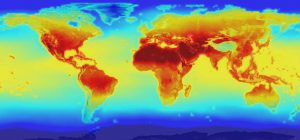By Chelsea Harvey
Agriculture has historically released almost as much carbon into the atmosphere as deforestation, a new study suggests — and that’s saying something.
In a paper published this week in Proceedings of the National Academy of Sciences, researchers found that land use changes associated with planting crops and grazing livestock have caused a loss of 133 billion tons of carbon from soil worldwide over the last 12,000 years, amounting to about 13 years of global emissions at their current levels. And at least half of those losses have probably occurred in the last few centuries.
“Historically, I think we’ve underestimated the amount of emissions from soils due to land use change,” said lead study author Jonathan Sanderman, an associate scientist with the Woods Hole Research Center, a climate change research organization based in Massachusetts.
The researchers suggest that the findings could be used to help target the places around the world that have lost the most soil carbon, and where restoration efforts — which aim to help store carbon back in the ground through sustainable land management — might make the greatest difference. It’s a strategy many scientists have suggested could be used to help fight climate change.
“We have known that extensive agricultural practices are responsible for depleting soil carbon stocks, but the full extent of these carbon losses has been elusive,” said soil expert Thomas Crowther, who will be starting a position as a professor of global ecosystem ecology at the Swiss Federal Institute of Technology in Zurich in October, in an email to The Washington Post. “In this study, the authors do a really good job of quantifying how humans have altered the Earth’s surface soil carbon stocks through extensive agriculture, with direct implications for atmospheric CO2 concentrations and the climate.”
Previously, studies on global soil carbon losses have varied wildly in their conclusions, suggesting historical losses of anywhere from 25 billion to 500 billion tons of carbon, Sanderman noted. In general, based on the average findings from multiple studies, scientists have often assumed a total loss of around 78 billion tons, he added.
Many of these past studies have relied on “simple bookkeeping estimates,” according to Sanderman, which involve calculating the carbon losses from one plot of land and then multiplying the results to get a value for the entire world.
But for the new study, the researchers were able to employ a large data set containing specific information on different soils from all around the world. They applied this data set to a model, along with another database on human land use and agricultural activity over the last 12,000 years, and added information on various other physical factors like climate and topography. Then they ran the model to see how soil carbon content has changed.
The model suggested that agricultural changes are responsible for the loss of a total of 133 petagrams, or 133 billion metric tons, of carbon from the top six-foot-deep layer of soil all over the world. The most intense losses per unit of land have been caused by the planting of crops — however, more land worldwide is devoted to grazing livestock than cropping. As a result, the study suggests that cropping and grazing are responsible for roughly equal shares of global soil carbon losses.
These losses have varied over time and in different locations as well, the study suggests. On a global scale, soil carbon losses have been speeding up since the industrial revolution, particularly in the 19th century. In the past 100 years, losses have tapered slightly, but still remain high, with the most significant emissions coming from new-world countries, such as Brazil, where large-scale agriculture is still expanding.
The researchers suggest that their findings could be used to help inform global efforts to improve soil carbon storage by pinpointing the parts of the world where losses have been highest — generally, places that have experienced the most intense agricultural conversion. And Crowther, the Netherlands Institute for Ecology researcher, added that “modifying large-scale agricultural practices to restore some of these lost soil carbon stocks might be a valuable strategy in our efforts to dampen climate change.”
That said, the researchers note that it’s essentially impossible to replace all 133 billion tons of lost carbon.
“If we allow natural vegetation to take over the world, we may eventually get close to that,” Sanderman suggested. “But obviously we need to feed 7 billion people, going up to 10 billion by the middle of the century, so the reality is we are not going to be abandoning agricultural land and restoring it to its native state in any large way.”
But, he added, there’s plenty of research to suggest that land can be managed in a more sustainable way.
“There’s a lot of studies showing that if you adopt recommended best management practices, you could slowly regain some fraction of that lost carbon,” he said.
Overall, the researchers suggest that with modified agricultural practices — which could include everything from more efficient crop rotation strategies to changes in the way land is plowed and tilled — we could realistically regain anywhere from 8 billion to 28 billion tons of the carbon that’s been lost.
And in the meantime, the study sheds some new light on our current climate situation, suggesting that human land use was likely a much more significant factor in the carbon emissions warming our planet than previously thought.
“We know how much carbon is in the atmosphere now,” Sanderman pointed out. “So that just changes how we apportion the blame historically.”




One Response to Agriculture’s role in climate change strategies – from the Washington Post